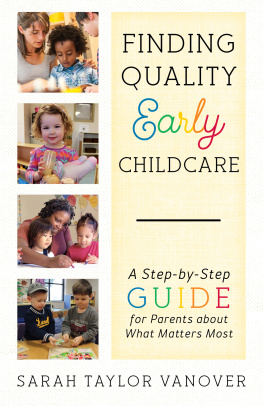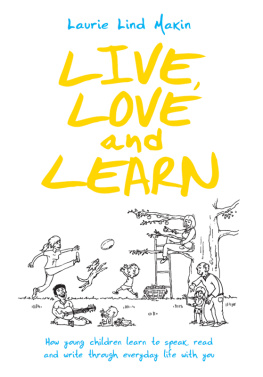The Beginnings of School Readiness
The Beginnings of School Readiness
Foundations of the Infant and Toddler Classroom
Sarah Taylor Vanover

Published by Rowman & Littlefield
A wholly owned subsidiary of The Rowman & Littlefield Publishing Group, Inc.
4501 Forbes Boulevard, Suite 200, Lanham, Maryland 20706
www.rowman.com
Unit A, Whitacre Mews, 26-34 Stannary Street, London SE11 4AB, United Kingdom
Copyright 2017 by Sarah Taylor Vanover
All rights reserved. No part of this book may be reproduced in any form or by any electronic or mechanical means, including information storage and retrieval systems, without written permission from the publisher, except by a reviewer who may quote passages in a review.
British Library Cataloguing in Publication Information Available
Library of Congress Cataloging-in-Publication Data
Includes bibliographic references.
ISBN: 978-1-4758-3587-8 (cloth : alk. paper)
ISBN: 978-1-4758-3588-5 (pbk. : alk. paper)
ISBN: 978-1-4758-3589-5 (electronic)
 The paper used in this publication meets the minimum requirements of American National Standard for Information SciencesPermanence of Paper for Printed Library Materials, ANSI/NISO Z39.48-1992.
The paper used in this publication meets the minimum requirements of American National Standard for Information SciencesPermanence of Paper for Printed Library Materials, ANSI/NISO Z39.48-1992.
Printed in the United States of America
This book is dedicated to my husband, Rob, who read each and every draft and supported me every step of the way!
Contents
School readiness has become a popular term for preparing each young child to be successful in kindergarten. With increased elementary school standards and teacher accountability, kindergarten expectations have become rigorous. Children spend much of their day sitting in seats while working on early reading and math skills. There has been a huge shift from the play-based learning environment seen a generation or two in the past to beginning a traditional elementary education with five-year-old students.
Although many kindergarten classrooms begin by teaching alphabet letters at the beginning of the school year, by winter break, students are focused on reading short words. Young students are required to follow directions, focus on the teachers lessons, and demonstrate self-control. Physical activity during the school day is limited due to large academic demands.
As families look ahead to these daunting academic standards, they are often tempted to begin teaching their children these academic skills at a young age. Families who place their children in childcare programs frequently ask the preschool classrooms to focus more on the academic piece of school readiness; however, that is only one portion of the skills needed to be prepared for kindergarten.
When you ask kindergarten teachers, they will frequently tell you that they have been trained to teach children the alphabet and how to read. That is part of the yearly curriculum that they plan for their students. When students arrive at kindergarten without well-developed social skills, the ability to follow instructions, or the ability to zip their own coats, the kindergarten teachers must stop their academic curriculum to address other skills.
By this standard, school readiness means more than a young child who can identify letters and numbers. It means more than a young child who is prepared to learn to read. School readiness addresses skills in all of the developmental (e.g., motor, language, cognition, social, and emotional areas skills). Families and early childhood educators need to view school readiness with regard to preparing the whole child for the next stage of life in elementary school.
Defining School Readiness
School readiness can be defined as each child beginning school with the skills that he or she needs in order to benefit, to learn, and to be successful. Many early childhood specialists believe that school readiness goes far beyond the abilities of the children. Children are strongly influenced by those in their natural environment like family members, friends, teachers, and members of the community, so it is essential that each childs community encourages learning and support (Maxwell and Clifford, 2004).
The families and childcare programs must work together to create an environment that gives the student confidence to try new things and learn from past mistakes. Relationships are the foundation for additional learning. The teachers and caregivers must determine how each child learns (i.e., visually, kinesthetically) and find learning strategies for that student to be successful. It is also essential for the first few years of learning to be positive experiences so that children develop a thirst for knowledge. When we look at the areas of school readiness and the skills that children need to enter school, they can be divided into five categories:
Health and physical growth
Language and communication skills
Social and emotional skills
Independence and disposition skills
Cognitive and academic skills
Areas of School Readiness
Using five broad categories for school readiness skills seems very vague until you analyze the skills in each category. Led by Pamela High (2008), the American Academy of Pediatrics created a summary of these categories. They described health and physical skills to include health status, growth, and disability. Social and emotional skills include turn-taking, cooperation, empathy, and the ability to express ones own emotions. Independence and disposition skills include self-help skills like feeding, diapering, and dressing, along with enthusiasm, curiosity, temperament, culture, and values. Language and communication skills include listening, speaking, and vocabulary, as well as literacy skills like print awareness, story sense, and writing and drawing processes. Cognitive skills include problem-solving, sound-letter association, spatial relations, and number concepts. A summative list of school readiness skills would look like this:
Health and physical growth
eats a balanced diet
gets plenty of rest
receives all required immunizations and medical exams
runs, jumps, climbs, and does other activities that develop large muscles
uses pencils, crayons, scissors, paints, and other small motor activities
Language and communication skills
will speak with children or adults
speaks in five-word or six-word sentences
takes turns in a conversation
sings simple songs
knows full name
reads and writes own name
can recite home address, phone number, and birthday
knows how a book works
recognizes familiar print from surroundings (logos, traffic signs, etc.)
listens and responds to stories read to them
uses scribbles and drawings to express ideas
recites the letters of the alphabet
Social and emotional skills
plays and shares with other children
follows simple rules and routines
demonstrates pretend play
expresses own needs and wants
explores and tries new things
separates easily from parents and family
works well alone
is able to focus on one activity until it is complete
asks for help when encountering a problem
Independence and disposition skills
uses the toilet without help
fastens and unfastens clothing without help (zippers, snaps, Velcro)
feeds oneself using utensils
helps put away toys or clothing







 The paper used in this publication meets the minimum requirements of American National Standard for Information SciencesPermanence of Paper for Printed Library Materials, ANSI/NISO Z39.48-1992.
The paper used in this publication meets the minimum requirements of American National Standard for Information SciencesPermanence of Paper for Printed Library Materials, ANSI/NISO Z39.48-1992.